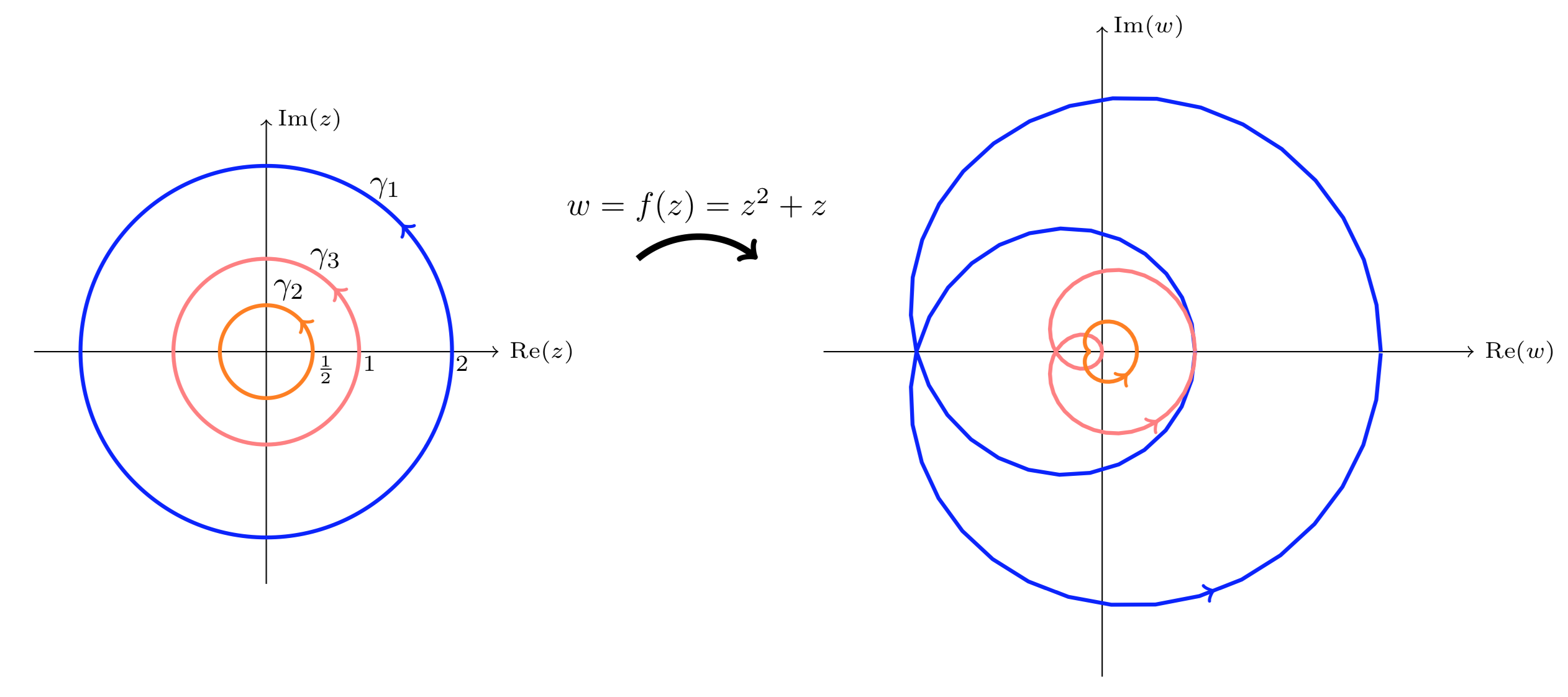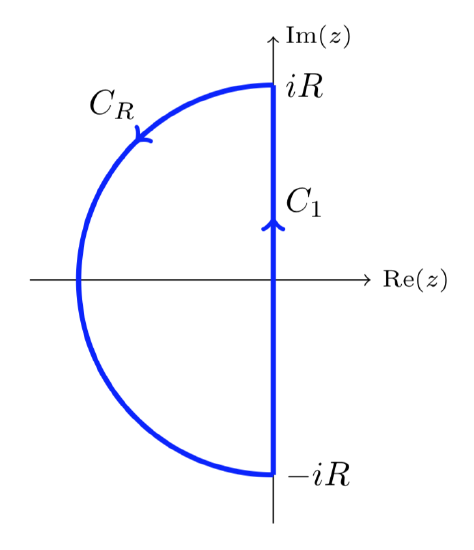12.1: Principle of the Argument
( \newcommand{\kernel}{\mathrm{null}\,}\)
Setup
γ a simple closed curve, oriented in a counterclockwise direction. f(z) analytic on and inside γ, except for (possibly) some finite poles inside (not on) γ and some zeros inside (not on) γ.
Let p1, ...,pm be the poles of f inside γ.
Let z1, ...,zn be the zeros of f inside γ.
Write mult(zk) = the multiplicity of the zero at zk. Likewise write mult(pk) = the order of the pole at pk.
We start with a theorem that will lead to the argument principle.
With the above setup
∫γf′(z)f(z) dz=2πi(∑mult(zk)−∑mult(pk)).
- Proof
-
To prove this theorem we need to understand the poles and residues of f′(z)/f(z). With this in mind, suppose f(z) has a zero of order m at z0. The Taylor series for f(z) near z0 is
f(z)=(z−z0)mg(z)
where g(z) is analytic and never 0 on a small neighborhood of z0. This implies
f′(z)f(z)=m(z−z0)m−1g(z)+(z−z0)mg′(z)(z−z0)mg(z)=mz−z0+g′(z)g(z)
Since g(z) is never 0, g′(z)/g(z) is analytic near z0. This implies that z0 is a simple pole of f′(z)/f(z) and
Res(f′(z)f(z),z0)=mmult(z0).
Likewise, if z0 is a pole of order m then the Laurent series for f(z) near z0 is
f(z)=(z−z0)−mg(z)
where g(z) is analytic and never 0 on a small neighborhood of z0. Thus,
f′(z)f(z)=−m(z−z0)−m−1g(z)+(z−z0)−mg′(z)(z−z0)−mg(z)=−mz−z0+g′(z)g(z)
Again we have that z0 is a simple pole of f′(z)/f(z) and
Res(f′(z)f(z),z0)=−m=−mult(z0).
The theorem now follows immediately from the Residue Theorem:
∫γf′(z)f(z) dz=2πi sum of the residues=2πi(∑mult(zk)−∑mult(pk)).
We write Zf,γ for the sum of multiplicities of the zeros of f inside γ. Likewise for Pf,γ. So the Theorem 12.2.1 says,
∫γf′f dz=2πi(Zf,γ−Pf,γ).
We have an intuition for what this means. We define it formally via Cauchy’s formula. If γ is a closed curve then its winding number (or index) about z0 is defined as
Ind(γ,z0)=12πi∫γ1z−z0 dz.
Mapping Curves: f∘γ
One of the key notions in this topic is mapping one curve to another. That is, if z=γ(t) is a curve and w=f(z) is a function, then w=f∘γ(t)=f(γ(t)) is another curve. We say f maps γ to f∘γ. We have done this frequently in the past, but it is important enough to us now, so that we will stop here and give a few examples. This is a key concept in the argument principle and you should make sure you are very comfortable with it.
Let γ(t)=eit with 0≤t≤2π (the unit circle). Let f(z)=z2. Describe the curve f∘γ.
Solution
Clearly f∘γ(t)=e2it traverses the unit circle twice as t goes from 0 to 2π.
Let γ(t)=it with −∞<t<∞ (the y-axis). Let f(z)=1/(z+1). Describe the curve f∘γ(t).
Solution
f(z) is a fractional linear transformation and maps the line given by γ to the circle through the origin centered at 1∕2. By checking at a few points:
f(−i)=1−i+1=1+i2, f(0)=1, f(i)=1i+1=1−i2, f(∞)=0.
We see that the circle is traversed in a clockwise manner as t goes from −∞ to ∞.

The curve z=γ(t)=it is mapped to w=f∘γ(t))=1/(it+1).
Argument Principle
You will also see this called the principle of the argument.
For f and γ with the same setup as above
∫γf′(z)f(z) dz=2πiInd(f∘γ,0)=2πi(Zf,γ−Pf,γ)
- Proof
-
Theorem 12.2.1 showed that
∫γf′(z)f(z) dz=2πi(Zf,γ−Pf,γ)
So we need to show is that the integral also equals the winding number given. This is simply the change of variables w=f(z). With this change of variables the countour z=γ(t) becomes w=f∘γ(t) and dw=f′(z) dz so
∫γf′(z)f(z) dz=∫f∘γdww=2πiInd(f∘γ,0)
The last equality in the above equation comes from the definition of winding number.
Note that by assumption γ does not go through any zeros of f, so w=f(γ(t)) is never zero and 1/w in the integral is not a problem.
Here is an easy corollary to the argument principle that will be useful to us later.
Assume that f∘γ does not go through −1, i.e. there are no zeros of 1+f(z) on γ then
∫γf′f+1=2πiInd(f∘γ,−1)=2πi(Z1+f,γ−Pf,γ).
- Proof
-
Applying the argument principle in Equation 12.2.11 to the function 1+f(z), we get
∫γ(1+f)′f(z)1+f(z) dz=2πiInd(1+f∘γ,0)=2πi(Z1+f,γ−P1+f,γ)
Now, we can compare each of the terms in this equation to those in Equation 12.2.14:
∫γ(1+f)′f(z)1+f(z) dz=∫γf′f(z)1+f(z) dz (because (1+f)′=f′)Ind(1+f∘γ,0)=Ind(f∘γ,−1) (1+f winds around 0 ⇔ winds around -1)Z1+f,γ=Z1+f,γ (same in both equation))P1+f,γ=Pf,γ (poles of f=poles of 1+f)
Let f(z)=z2+z Find the winding number of f∘γ around 0 for each of the following curves.
- γ1 = circle of radius 2.
- γ2 = circle of radius 1/2.
- γ3 = circle of radius 1.
Solution
f(z) has zeros at 0, −1. It has no poles.
So, f has no poles and two zeros inside γ1. The argument principle says Ind(f∘γ1,0)=Zf,γ1−Pf,γ=2
Likewise f has no poles and one zero inside γ2, so Ind(f∘γ2,0)=1−0=1
For γ3 a zero of f is on the curve, i.e. f(−1)=0, so the argument principle doesn’t apply. The image of γ3 is shown in the figure below – it goes through 0.

The image of 3 different circles under f(z)=z2+z.
Rouché’s Theorem
Make the following assumptions:
- γ is a simple closed curve
- f,h are analytic functions on and inside γ, except for some finite poles.
- There are no poles of f and h on γ.
- |h|<|f| everywhere on γ.
Then
Ind(f∘γ,0)=Ind((f+h)∘γ,0).
That is,
Zf,γ−Pf,γ=Zf+h,γ−Pf+h,γ
- Proof
-
In class we gave a heuristic proof involving a person walking a dog around f∘γ on a leash of length h∘γ. Here is the analytic proof.
The argument principle requires the function to have no zeros or poles on γ. So we first show that this is true of f,f+h,(f+h)/f. The argument is goes as follows.
Zeros: The fact that 0≤|h|<|f| on γ implies f has no zeros on γ. It also implies f+h has no zeros on γ, since the value of h is never big enough to cancel that of f. Since f and f+h have no zeros, neither does (f+h)/f.
Poles: By assumption f and h have no poles on γ, so f+h has no poles there. Since f has no zeors on γ, (f+h)/f has no poles there.
Now we can apply the argument principle to f and f+h
12πi∫γf′f dz=Ind(f∘γ,0)=Zf,γ−Pf,γ.
12πi∫γ(f+h)′f+h dz=Ind((f+h)∘γ,0)=Zf+h,γ−Pf+h,γ.
Next, by assumption |hf|<1, so (hf)∘γ is inside the unit circle. This means that 1+hf=f+hf maps γ to the inside of the unit disk centered at 1. (You should draw a figure for this.) This implies that
Ind((f+hf)∘γ,0)=0.
Let g=f+hf. The above says Ind(g∘γ,0)=0. So, ∫γg′g dz=0. (We showed above that g has no zeros or poles on γ.)
Now, it's easy to compute that g′g=(f+h)′f+h−f′f. So, using
Ind(g∘γ,0)=∫γg′g dz=∫γ(f+h)′f+h dz−∫γf′f dz=0⇒Ind((f+h)∘γ,0)=Ind(f∘γ,0).
Now equations 12.2.19 and 12.2.20 tell us Zf,γ−Pf,γ=Zf+h,γ−Pf+h,γ, i.e. we have proved Rouchés theorem.
Under the same hypotheses, If h and f are analytic (no poles) then
Zf,γ=Zf+h,γ.
- Proof
-
Since the functions are analytic Pf,γ and Pf+h,γ are both 0. So Equation 12.2.18 shows Zf=Zf+h. QED
We think of h as a small perturbation of f.
Show all 5 zeros of z5+3z+1 are inside the curve C2:|z|=2.
Solution
Let f(z)=z5 and h(z)=3z+1. Clearly all 5 roots of f (really one root with multiplicity 5) are inside C2. Also clearly, |h|<7<32=|f| on C2. The corollary to Rouchés theorem says all 5 roots of f+h=z5+3z+1 must also be inside the curve.
Show z+3+2ez has one root in the left half-plane.
Solution
Let f(z)=z+3, h(z)=2ez. Consider the contour from −iR to iR along the y-axis and then the left semicircle of radius R back to −iR. That is, the contour C1+CR shown below.

To apply the corollary to Rouchés theorem we need to check that (for R large) |h|<|f| on C1+CR. On C1, z=iy, so
|f(z)|=|3+iy|≥3, |h(z)|=2|eiy|=2.
So |h|<|f| on C1.
On CR, z=x+iy with x<0 and |z|=R. So,
|f(z)|>R−3 for R large, |h(z)|=2|ex+iy|=2ex<2 (since x<0).
So |h|<|f| on CR.
The only zero of f ia at z=−3, which lies inside the contour.
Therefore, by the Corollary to Rouchés theorem, f+h has the same number of roots as f inside the contour, that is 1. Now let R go to infinity and we see that f+h has only one root in the entire half-plane.
Rouchés theorem can be used to prove the fundamental theorem of algebra as follows.
- Proof
-
Let
P(z)=zn+an−1zn−1+ ...+a0
be an nth order polynomial. Let f(z)=zn and h=P−f. Choose an R such that R>max(1,n|an−1|,...,n|a0|). Then on |z|=R we have
|h|≤|an−1|Rn−1+|an−2|Rn−2+ ...+|a0|≤RnRn−1+RnRn−2+ ...+Rn<Rn.
On |z|=R we have |f(z)|=Rn, so we have shown |h|<|f| on the curve. Thus, the corollary to Rouchés theorem says f+h and f have the same number of zeros inside |z|=R. Since we know f has exactly n zeros inside the curve the same is true for the polynomial f+h. Now let R go to infinity, we’ve shown that f+h has exactly n zeros in the entire plane.
The proof gives a simple bound on the size of the zeros: they are all have magnitude less than or equal to max(1,n|an−1|,...,n|a0|).

